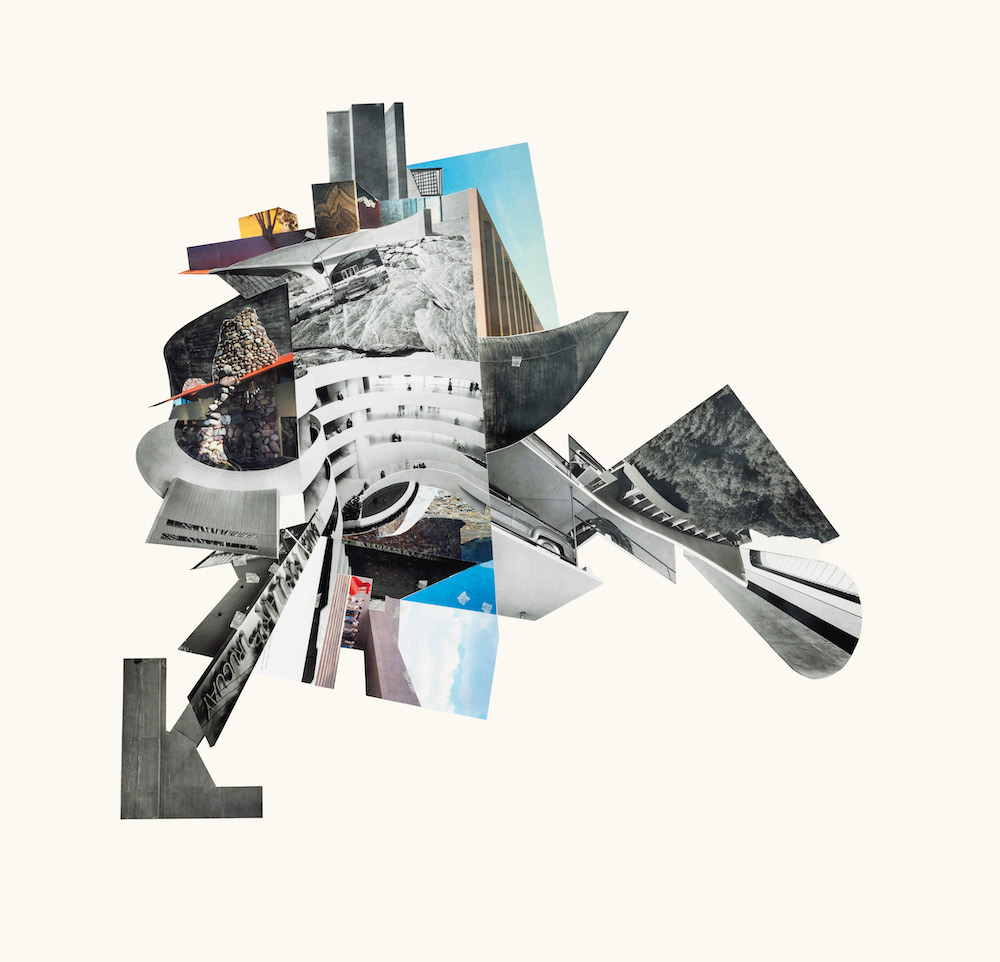One half of Chicago’s famous corn cob buildings, formally known as Marina City, floats above a winding road in a mountain pass. It pierces a white void, which highlights the building’s delicate edges, the bite marks in its ocular facade. Below, light streams through an open pit, illuminating a subterranean realm. There are thin, precise incisions along the collage, which are then mended with irregular strips of blue painter’s tape. The Round Tower (2021) is one of Marshall Brown’s many paper monsters in his solo exhibition “Marshall Brown: The Architecture of Collage” at the Santa Barbara Museum of Art.
Collage is inherently about creating unexpected amalgamations, and Brown uses the medium to build grotesque labyrinthine architectures and opaque, impassable cities. A licensed architect, urbanist and professor at Princeton University, Brown taps into his deep knowledge of architectural history. Primarily working with reference materials like old trade journals, magazine back issues and historical maps, Brown is an analog world builder crafting the future from jewels of the past.
The Round Tower references another work of the same name, created by Italian Renaissance artist Giovanni Battista Piranesi for his series “Carceri d’invenzione” (Imaginary Prisons) circa 1749–50. In Piranesi’s etching, staircases loop around a panoptic stone building, which Brown echoes in his own collage with Marina City. Piranesi combined archways, staircases, windows and cantilevers from his real-life surroundings to create these winding environments. Brown—long fascinated with Piranesi’s method of building the impossible with existing architecture—uses this work as a launching point for his own series, “Prisons of Invention.” Many of these works are included in this exhibition.

Marshall Brown, The Gothic Arch, 2021. Collage on archival paper. Courtesy Marshall Brown Projects and Western Exhibitions, Chicago. © 2022, Marshall Brown Projects.
Brown mounts his free-form collages on large, blank archival paper, often embossed in the corner with his architecture license, and suspends their edges in a void. In Pantheon (2020), the curved walkway of the Guggenheim blends into many improbable routes. One ramp takes you to a mid-century modern stone facade, another extends downwards into an arrow that points into emptiness . Frank Lloyd Wright’s beautiful museum becomes a fortress with no clear exits. There are suggestions of blue skies, clouds and trees, but these features are turned on their axis and made inaccessible to its wanderers.
Other collages in this series prominently show concrete in repetitious forms that are strongly associated with both Brutalism and Futurism. Two figures occupy opposite ends of the composition in Prisoners on a Projecting Platform (2021), framed in circular, concrete apertures. They are separated by a mundane office building’s window facade, but in this context it mimics a jail cell’s barred doors. In Brown’s re-imaginings of prisons, aesthetics have been improved, but people are still caged.
This theme—that ideologies from the past will continue to be embedded into the future—runs through Brown’s exhibition. His “Chimera” series incorporates recognizable fragments of Le Corbusier, a Nazi sympathizer. Another, 14-03-10 (2010), samples Zaha Hadid, who was criticized for using forced labor (although the art center featured in this particular collage is not part of that controversy). Preserving these architects’ signature styles, even in fantastical configurations, means that the darker parts of their legacies will linger, but the people inhabiting Brown’s collages don’t seem troubled by these histories. A woman straight out of the 1960s lounges on a red sofa in A Choice to Do Both (2019). She gazes into the blank part of the canvas, oblivious to the architecture surrounding her.

Marshall Brown, Chimera, 2014. Collaged magazine pages, glue on archival paper. Museum of Contemporary Photography at Columbia College Chicago, Museum purchase, 2018:8. © 2022, Marshall Brown Projects.
It’s rare to see human figures doing anything but idling in Brown’s collages. They’re captured standing around at art museums, waiting at airports and gazing from balconies. It’s due to the nature of Brown’s source material; glossy celebrations of architectural achievements in which people simply marvel at their surroundings. People don’t seem to work or struggle, other than the three construction workers in 13-12-31 (2013) who are surrounded by cranes and steel. The laborers are outnumbered by the ruling class, living in the margins, visible only when they’re building Brown’s modular structures.
As much as Brown’s exhibition evokes the past, one can envision a speculative future that emerges from the historical imagery. A newer body of work, Brown’s Piranesian Map of Berlin (2022), inspired by Piranesi’s map of the Campus Martius (1762), repackages Berlin as a sprawling super-city in which the population has exploded and new development has kept pace.
Brown built this map with different types of urban diagrams that the German government produced before the reunification of East and West Berlin. The colorful zoning charts, street plans and topographic drawing fuse contradictory geographies, creating a Kafkaesque infrastructural failure. Navigating this speculative Berlin recalls Kafka’s protagonist in The Castle, K., who cannot access the titular castle and instead ambles through the surrounding village, bouncing from one dead end to the next.
While “The Architecture of Collage” has a shining surface, a closer read of the work reveals that the future of urbanism might be more dystopic than utopian. But we can still grab on to the beautiful imagery in Brown’s new worlds. We are already in an era of modular design, where homeowners are converting container ships into resorts and cheap, prefabricated cubes can be stacked into Accessory Dwelling Units. Brown shows that design can instead be more freestyle and organic. We could maintain the craftsmanship that created so many architectural icons, like Marina City, but we must also be careful not to transform them into prisons of invention.


